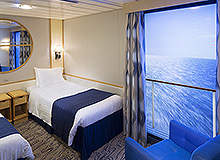

Virtual Balcony
Virtual Balcony, a new concept introduced by Royal Caribbean, allows cruisers travelling in interior staterooms enjoy real time view and sound of the sea with the help of an 80-inch floor-to-ceiling high-definition LED display screen installed on the cabin wall. The screen constantly streams a video feed obtained from cinematic cameras fitted in the ship’s exterior and is framed to appear like a real balcony.
Royal Caribbean’s Navigator of the Seas, which is fitted with virtual balconies in 81 of the 643 standard interior cabins, is the world’s first to feature this innovation. The company’s new build cruise ship Quantum of the Seas, which is scheduled to be launched in November 2014, will feature virtual balconies in 373 of its interior rooms.
Skydiving Simulator
RipCord by iFly, the first ever skydiving simulator in a cruise ship, will feature aboard Royal Caribbean’s Quantum of the Seas and comprise of glass flight camber and use wind tunnel technology to give the cruisers a realistic feel of soaring up to 10,000ft high in the air.
RipCord is a controlled environment where people of all ages, accompanied by trained instructors, can enjoy the thrill and adventure of skydiving with friends and family cheering on from outside the glass chamber.


US Tariffs are shifting - will you react or anticipate?
Don’t let policy changes catch you off guard. Stay proactive with real-time data and expert analysis.
By GlobalDataNorth Star capsule
North Star, a jewel-shaped glass capsule to be featured in Royal Caribbean’s two new cruise ships Quantum of the Seas and Anthem of the Seas, will elevate cruisers to more than 300ft above sea level for a 360° view of the sea and any upcoming destinations.
The bubble-like structure fitted on the top deck towards the bow of the ship will offer a 15-minute unprecedented journey up above the sea to as many as 13 guests at a time. Guests can experience the flight in North Star capsule under three premium packages available for advance booking. The packages include the sunrise and sunset flights as well as private flights for special occasions.
Magical Porthole
Disney Dream and Disney Fantasy, two of the Disney cruise line ships, feature magical portholes inside staterooms to give the passengers a real-time ocean view reflecting the actual stateroom’s location. The magical porthole can be turned off with a quick flip of the switch while taking rest.
The high definition cameras installed on the ship’s exterior feed live video to a flat screen display monitor designed with a nautical frame giving it a porthole-like appearance. Disney animated characters also pop up on the virtual porthole screens from time to time for added visual pleasure.

LCD Wayfinder
LCD Wayfinders or self service kiosks contain interactive touch screens to enable guests and employees to browse through the ever updated activities schedule onboard and find their way around the ship. Royal Caribbean’s Oasis and Allure of the Seas were the first ships to be fitted with LCD Way finders, while the technology has gradually been rolled out to the rest of their fleet.
The LCD Wayfinder system was developed by Four Winds Interactive and won a number awards in 2011 for technological excellence including the ones from the Digital Screenmedia Association and Hospitality Technology magazine.
Facial Recognition
Facial recognition, a form of biometrics, is used by Disney Cruise Line’s two latest ships Disney Dream and Disney Fantasy to sort the huge number of photos that Disney takes and sells to the passengers. The technology is also used in the ship’s moving picture exhibits that play a photo slide show of the vacationer standing in front of them.
Facial recognition technology ensures a particular sequence of photos is not played more than once for a particular passenger. Royal Caribbean is also using facial recognition software that allows computers to categorise the photos taken in the ship so that the cruisers can easily pickup their photos later.

Shape Recognition Cameras and Interactive Media
Royal Caribbean’s Oasis of the Seas and Allure of the Seas are using shape recognition cameras and interactive media system to avoid passengers waiting at onboard restaurants.
Shape recognition cameras installed in each of the restaurants count the number of seating and waiting passengers and transmit the data in real time in the form of red-yellow-green signals to hundreds of digital signs around the ship allowing the passengers to self-select the least-crowded restaurants aboard the ship.
Smart phone and iPad-based Applications
Cruise lines have integrated smart phones and tablets in many ways to enhance the onboard experiences of their guests. Norweigian Cruise Line’s iConcierge mobile application used in the Norwegian Epic cruise ship, for instance, allows guests to find and communicate with other via voice and text message. The application also allows the iPhone and iPad users to make dining and shore excursion reservations as well as to check scheduled activities on the cruise ship.
Passengers on Royal Caribbean’s Oasis of the Seas and Allure of the Seas can rent a mobile device called Royal Connect to keep track of family or colleagues onboard. The communication system comprises of wristbands with Radio Frequency Identification Technology (RFID) tags and an iPhone that tracks the tag locations on its map display. The use of iPad-based menus to select dish and order customised wines and cocktails in bars and restaurants, as well as to track events and activities is gradually becoming common.

Guest Evolution Entertainment
Guest Evolution, a technology platform that offers the world’s first HTML5 based smart TV solution to passenger and crew, is installed on Royal Princess, the new ship in the Princess fleet that sailed for maiden voyage in June 2013.
Princess Cruises partnered with UIEvolution to deploy this platform, which allows browser-based smart TV application on interactive TVs that can be extended to support a range of innovative features including screen shifting live TV; movies and music on demand; on-board mapping and routing; and viewing the schedule of ship activities as well as the restaurant and wine menus.



